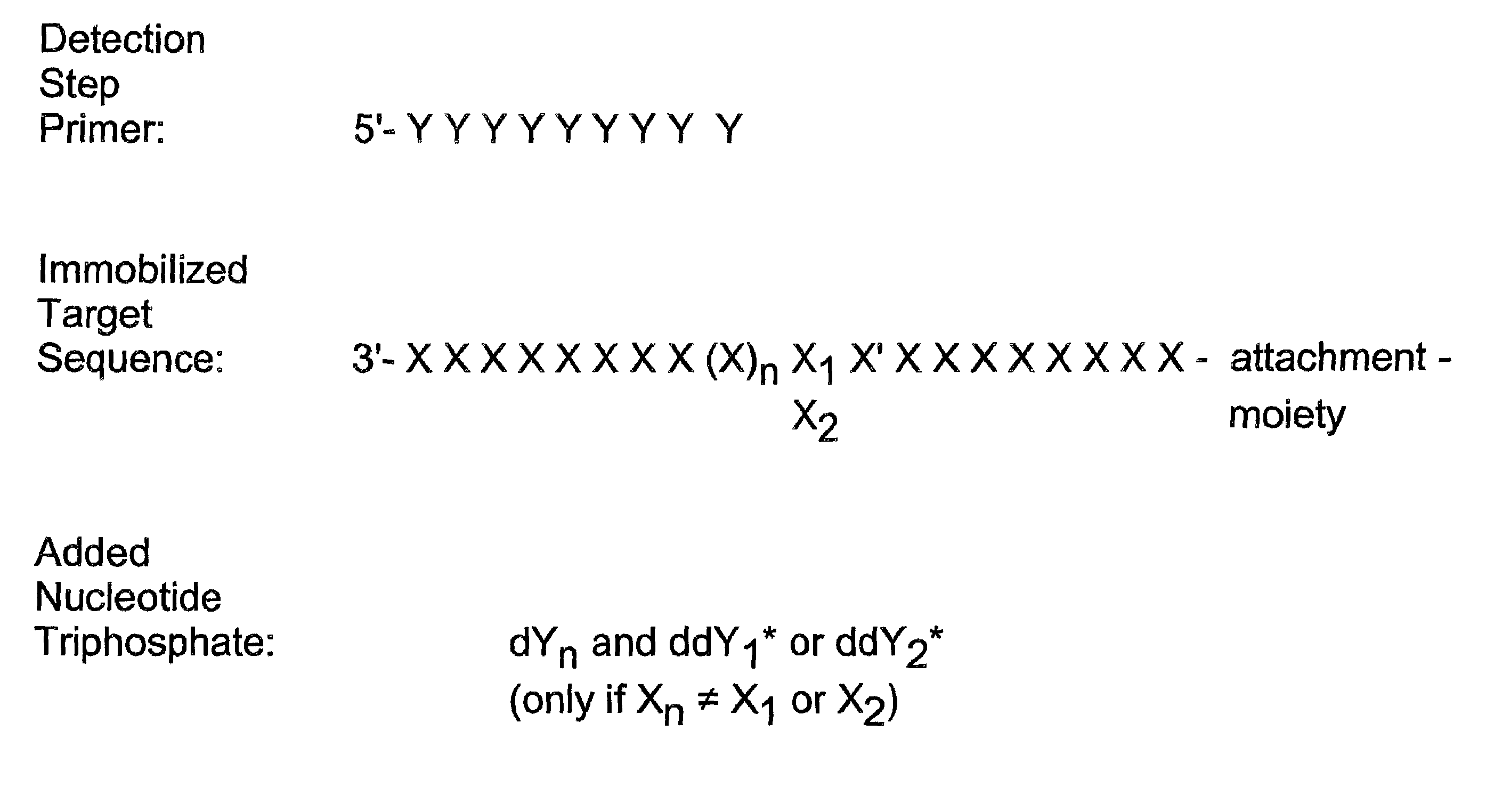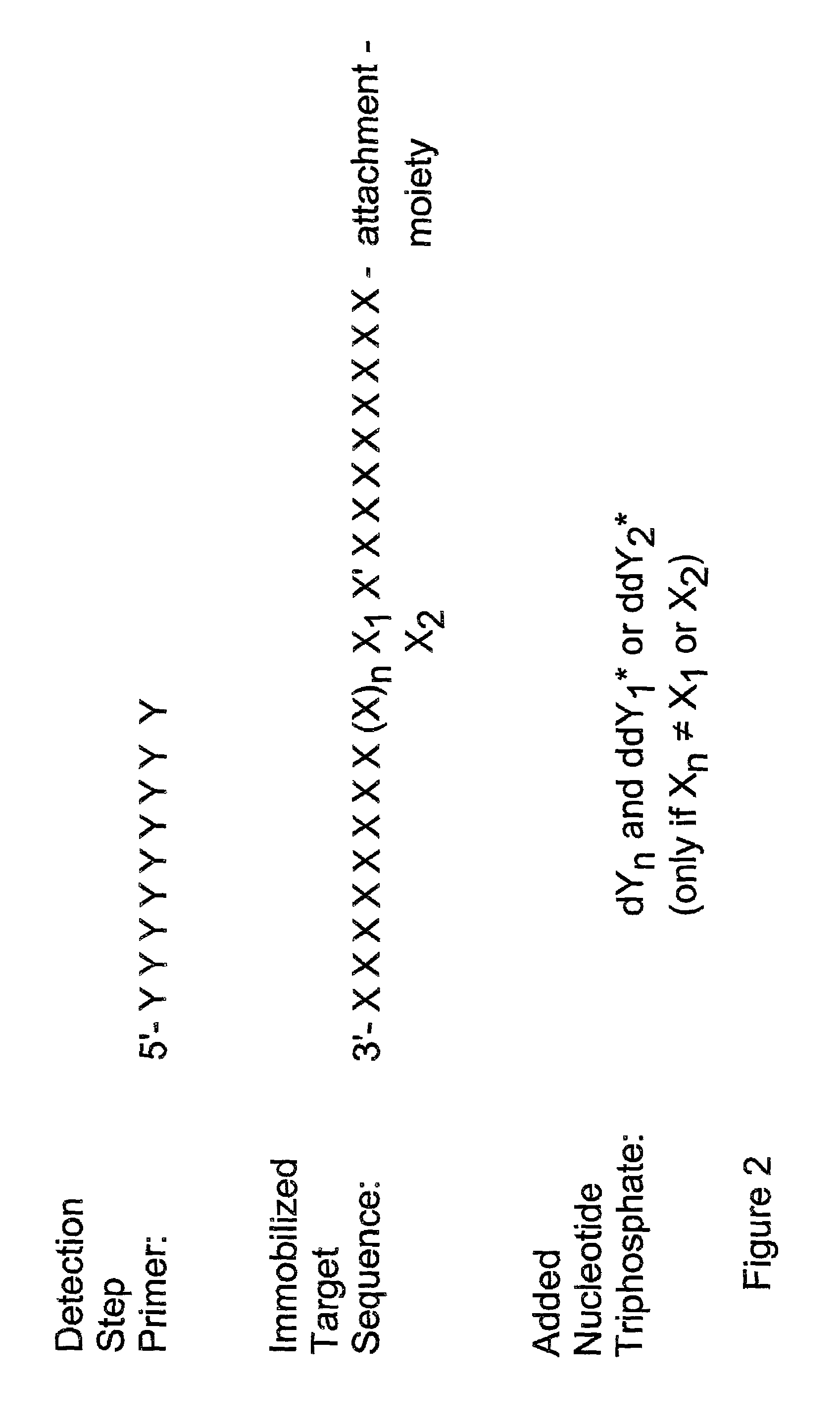Method for determining specific nucleotide variations
a specific nucleotide and variation technology, applied in the field of specific nucleotide variations, to achieve the effect of easy automation and small and easy-to-perform procedures
- Summary
- Abstract
- Description
- Claims
- Application Information
AI Technical Summary
Benefits of technology
Problems solved by technology
Method used
Image
Examples
example 1
[0075]Identification of the apolipoprotein E polymorphism in the codons for amino acid residues 112 and 158 using [35S] as label
Synthesis of Oligonucleotides
[0076]Four PCR primers (P1–P4) and two detection step oligonucleotide primers (D1 and D2) were synthesized on an Applied Biosystems 381A DNA synthesizer. The nucleotide sequence of the oligonucleotides, and their location (given as nucleotide numbers) on the apolipoprotein E gene (Apo E) were:
[0077]
P1: 5′-AAG GAG TTG AAG GCC TAC AAA T(3616–3637)P3: 5′-GAA CAA CTG AGC CCG GTG GCG G(3649–3670)D1: 5′-GCG CGG ACA TGG AGG ACG TG (3725–3744)D2: 5′-ATG CCG ATG ACC TGC AGA AG (3863–3882)P2: 5′-TCG CGG GCC CCG GCC TGG TAC A(3914–3893)P4: 5′-GGA TGG CGC TGA GGC CGC GCT C(3943–3922)
[0078]A 5′-aminogroup was added to the primer P2 with the aminolink II reagent (Applied Biosystems). The amino group was biotinylated using sulfo-NHS-biotin (Pierce Chemical Co.) and purified by reverse phase HPLC.
The DNA Samples
[0079]Venous blood samples were o...
example 2
[0090]Identification of the variable nucleotide in codon 112 of the apolipoprotein E gene using double labelling ([3H] and [32P]) in one reaction.
Oligonucleotides and DNA Samples
[0091]The PCR primers P1, biotinylated P2, P3 and P4, and the detection step primer D1 described in Example 1 were used in this example. The DNA was extracted from blood samples as described in Example 1.
Polymerase Chain Reaction-Amplification and Affinity-Capture
[0092]The PCR amplification and the affinity-capture of the amplified fragments were carried out as described in Example 1. In the last washing step each sample was divided into two aliquots.
Identification of the Variable Nucleotide at Codon 112
[0093]The particles were suspended in 10 μl of buffer (see Example 1) containing 2 pmol of the detection step primer D1, which hybridizes immediately 3′ to the variable nucleotide in codon 112. The annealing reaction was carried out as in Example 1. One μl of 0.1 M DTT was added.
[0094]The identification of th...
example 3
[0098]Identification of the variable nucleotide in codon 158 of the apolipoprotein E gene after a single polymerase chain reaction amplification.
Oligonucleotides and DNA Samples
[0099]In this example the biotinylated primer P2 and the primer P3 were used in the PCR amplification. The detection step primer was D2 (see Example 1). The DNA was extracted from venous blood as described in Example 1.
Polymerase Chain Reaction-Amplification and Affinity-Capture
[0100]The DNA (100 ng per sample) was amplified with the biotinylated P2 and the P3 primer (final concentration 1 μM) at the conditions described in Example 1 with the following exception: Only one amplification process consisting of 30 cycles of 1 min. at 96° C., 1 min. at 55° C. and 1 min. 72° C. was carried out.
[0101]The affinity-capture on avidin-coated polystyrene particles was done as in Example 1. Each sample was divided into two parts in the last washing step.
Identification of the Variable Nucleotide in Codon 158
[0102]The parti...
PUM
| Property | Measurement | Unit |
|---|---|---|
| concentration | aaaaa | aaaaa |
| concentration | aaaaa | aaaaa |
| pH | aaaaa | aaaaa |
Abstract
Description
Claims
Application Information
 Login to View More
Login to View More - R&D
- Intellectual Property
- Life Sciences
- Materials
- Tech Scout
- Unparalleled Data Quality
- Higher Quality Content
- 60% Fewer Hallucinations
Browse by: Latest US Patents, China's latest patents, Technical Efficacy Thesaurus, Application Domain, Technology Topic, Popular Technical Reports.
© 2025 PatSnap. All rights reserved.Legal|Privacy policy|Modern Slavery Act Transparency Statement|Sitemap|About US| Contact US: help@patsnap.com



